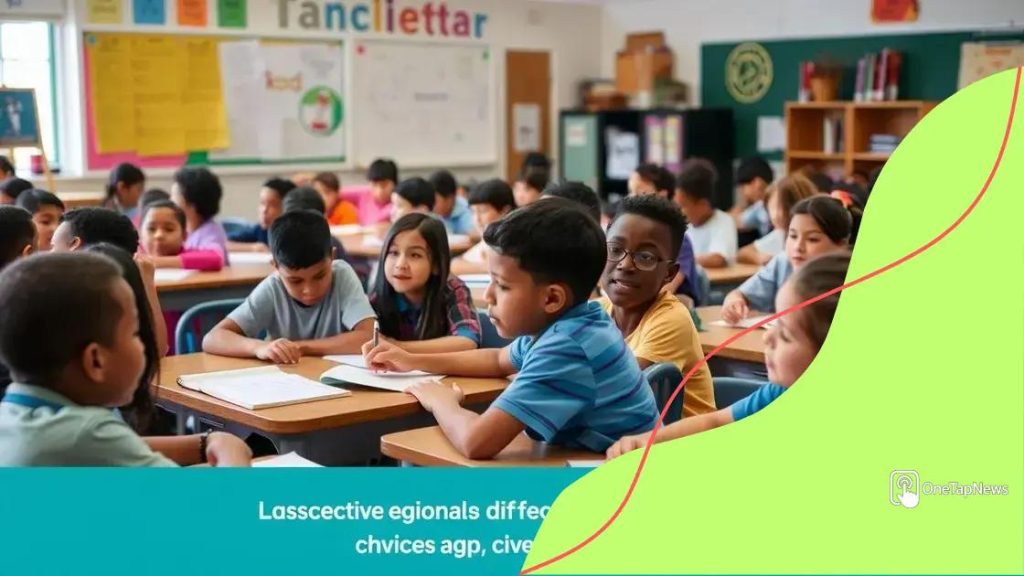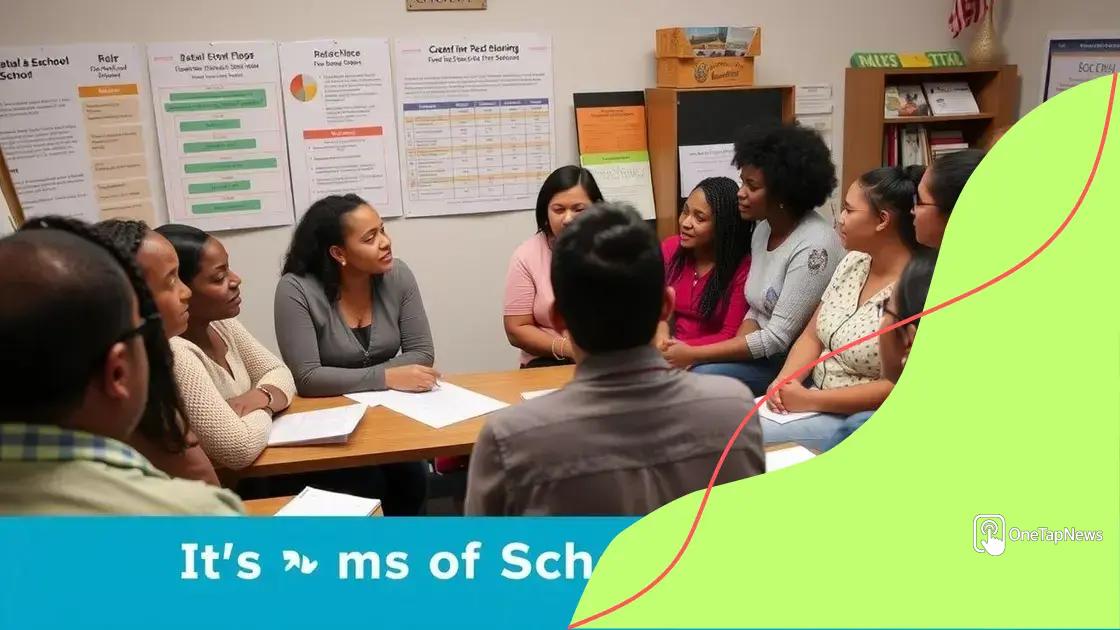School choice impact studies: exploring the effects

Anúncios
School choice impact studies reveal that selecting educational options tailored to students can significantly enhance academic performance, though challenges such as equity and resource allocation must be addressed.
The school choice impact studies offer fascinating insights into how various educational options shape student outcomes and community dynamics. Have you ever wondered how these choices affect your child’s education?
Anúncios
Understanding school choice and its significance
When we talk about school choice, we refer to the various options parents have to select educational settings for their children. This can include public, private, charter, and homeschooling options. Understanding the significance of these choices is essential for parents and educators alike.
The decision to choose a school is not solely based on personal preference; it is influenced by many factors. School choice impacts not just academic outcomes but also the social environment and community dynamics.
Factors Influencing School Choice
Several elements play a role in school selection:
Anúncios
- Academic performance and reputation
- Location and accessibility
- Extracurricular activities and programs
- School safety and environment
Each family will weigh these factors differently, based on their individual needs and values. For instance, a family may prioritize academic performance over school location, while another might focus on extracurricular activities.
Interestingly, school choice has also led to a shift in how education systems operate. Schools now compete for students, which can improve overall educational quality. This competition pushes schools to enhance their curriculum and ensure successful outcomes for their students.
Community Impact
The effects of school choice go beyond individual families. Communities also experience changes, particularly in terms of resources and funding. When students move from one school to another, it can affect the funding structures and resource allocation within districts.
Additionally, school choice encourages diversity in educational philosophies and practices. Different schools can offer unique approaches to teaching, catering to various learning styles.
As we explore the significance of school choice, it’s essential to recognize both the advantages and challenges that come with these options. The conversation should also include how to support families in making informed decisions.
Positive effects of school choice on student performance
The positive effects of school choice on student performance can be profound. Families who select schools that align with their values and expectations often see better outcomes for their children. Tailoring education to fit the student’s needs is crucial for success.
Research indicates that when students attend schools that match their learning styles, they tend to perform better academically. This leads to increased engagement and motivation within the classroom, which are key to achieving long-term educational goals.
Academic Improvement
One of the notable benefits of school choice is the potential for improved academic performance. Studies have shown that:
- Students in chosen schools often experience higher test scores.
- Attendance rates are typically better in schools that families select.
- Graduation rates can increase, especially in competitive environments.
- Access to specialized programs can enhance student learning.
These elements create a supportive atmosphere conducive to learning. When families choose a school that meets their children’s needs, it often leads to greater academic success.
Moreover, school choice encourages innovation in teaching methods. Schools strive to provide unique curricula and programs to attract families. This competition can drive schools to adopt new strategies that benefit students.
Social and Emotional Development
Beyond academics, school choice can enhance social and emotional development. Environments where students feel comfortable can lead to stronger relationships with peers and teachers. These positive interactions often boost self-esteem and foster a love for learning.
Additionally, students in chosen schools may have opportunities to participate in diverse extracurricular activities. Engaging in sports, arts, and community service can significantly enrich the educational experience.
In summary, the positive effects of school choice extend beyond academic achievement. Students can benefit from improved performance, greater engagement, and enhanced social skills, setting them up for success in their future endeavors.
Challenges and criticisms of school choice

While school choice offers many benefits, it also faces significant challenges and criticisms that are important to consider. These issues can affect students, families, and education systems alike, leading to complex discussions about its effectiveness.
One major challenge is equity. Parents in wealthier areas often have more options and resources when it comes to choosing schools. This situation can leave families in lower-income neighborhoods with fewer choices, which may not meet their children’s needs.
Critiques of School Choice
Critics argue that school choice can lead to:
- Increased segregation, as families may choose schools based on racial or socio-economic lines.
- Resource depletion in public schools, as funding often follows students to their chosen school.
- Accountability issues, since some private and charter schools might not be held to the same educational standards as public schools.
- Limited access for students with special needs, who may not be adequately supported in some chosen environments.
These critiques raise important questions about fairness and quality in education. As communities navigate the implications of school choice, it’s crucial to address these concerns collaboratively.
Additionally, the shifting landscape of school choice can create confusion about how education funding works. Parents might not fully understand the financial implications of their choices, which can lead to unexpected consequences for families and schools.
Impact on Public Schools
The impact on traditional public schools is another area of concern. When students leave for other educational options, the funding for these schools can decrease, leading to larger class sizes and fewer resources. Public school teachers may face increased pressure to perform, yet have less support due to funding cuts.
Discussions around school choice are essential for shaping effective policies that consider all voices. Listening to different stakeholders, including teachers, parents, and students, can help find solutions that address these challenges while ensuring quality education for every child.
Comparative analysis of different school systems
Understanding the differences among various school systems is vital for making informed educational choices. A comparative analysis of school systems helps parents and educators evaluate the strengths and weaknesses of each option available.
Different school systems can vary significantly in terms of curriculum, funding, governance, and student outcomes. Such diversity allows families to find educational environments that best suit their needs.
Types of School Systems
In general, there are several types of school systems, including:
- Public schools, funded and operated by government entities.
- Charter schools, which operate independently but receive public funding.
- Private schools, funded through tuition and private donations.
- Homeschooling, where parents take full responsibility for their children’s education.
Each of these systems has unique characteristics that can impact student learning and overall experience. For example, public schools often focus on standardized curriculum, while charter schools may have more flexibility to innovate educational practices.
Additionally, private schools might offer specialized programs unattainable in traditional public education. This variety promotes diverse learning pathways and allows families to select a system that aligns with their educational values.
Student Performance Across Systems
Numerous studies have been conducted to compare student performance across different school systems. Findings can vary, but some key aspects often discussed include:
- Standardized test scores, which can highlight academic achievement levels.
- Graduation rates, indicating overall student success.
- Access to advanced placement (AP) and extracurricular options.
It is essential to consider that more than just performance metrics define a school system’s effectiveness. Factors like community involvement, teacher experience, and social-emotional support play a significant role in a student’s overall education.
Through a thoughtful comparative analysis, families can weigh their options effectively. By examining various school systems and understanding their implications, parents can make choices that will positively impact their children’s futures.
Future trends in school choice policies
As we look ahead, understanding the future trends in school choice policies is essential. These trends can shape how education systems evolve and how families make decisions in the coming years.
With increasing demand for personalized education, many states are reconsidering their regulations regarding school choice. This shift may lead to more flexible options for families, allowing them to find schools that best fit their children’s needs.
Emerging Policy Changes
Some of the potential changes in school choice policies include:
- Greater funding for charter schools, enabling them to expand and offer more specialized programs.
- More educational savings accounts (ESAs) that allow families to use public funds for private education or homeschooling expenses.
- Expanded school choice options for students with disabilities, ensuring access to tailored educational settings.
- Increased transparency and accountability for all types of schools to ensure quality education standards.
These emerging policies could create a more inclusive educational landscape, making it easier for families to make informed choices.
Another trend gaining traction is the use of technology in education. Online learning and digital resources are becoming integral parts of classrooms. This shift can lead to more hybrid education models, where students have the flexibility to choose between in-person and online learning environments.
Community and Parental Involvement
In the future, there may also be a stronger emphasis on community and parental engagement in school choice decisions. Schools might start implementing more feedback mechanisms, allowing parents and students to voice their opinions on school quality and needed changes.
Effective communication between schools and families will be key to understanding community needs and improving educational offerings. Engaging parents in the decision-making process can foster trust and collaboration, ultimately enhancing student outcomes.
Understanding these potential future trends in school choice policies will be crucial for families as they navigate their educational options. Staying informed about these shifts can help parents and educators advocate for effective and equitable educational opportunities for all students.
In conclusion, understanding school choice is vital for parents and educators. The benefits of choosing the right educational environment are immense, positively impacting academic performance and student well-being. However, challenges and criticisms remain that must be addressed. Looking forward, staying informed about emerging trends in school choice policies will help families make better choices for their children’s futures. By engaging with communities and embracing innovative educational practices, we can work towards a more equitable and effective education system for all students.
FAQ – Frequently Asked Questions about School Choice Impact Studies
What is school choice?
School choice allows families to select educational options for their children, including public, private, charter, and homeschooling.
How does school choice affect student performance?
Research shows that school choice can lead to improved academic performance, as families can select schools that align with their children’s learning needs.
What are the main challenges associated with school choice?
Challenges include equity issues, resource allocation concerns, and the potential for increased segregation among students.
What future trends can we expect in school choice policies?
Future trends may include more personalized education options, increased use of technology, and greater community involvement in education decisions.